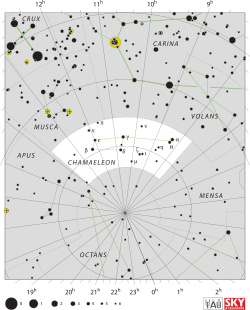- Chamaeleon
-
Chamaeleon Constellation 
List of stars in ChamaeleonAbbreviation Cha Genitive Chamaeleontis Pronunciation /kəˈmiːliən/, genitive /kəˌmiːliˈɒntɨs/ Symbolism the Chameleon Right ascension 11 h Declination −80° Quadrant SQ2 Area 132 sq. deg. (79th) Main stars 3 Bayer/Flamsteed
stars16 Stars with planets 1 Stars brighter than 3.00m 0 Stars within 10.00 pc (32.62 ly) 0 Brightest star α Cha (4.05m) Nearest star α Cha
(63.45 ly, 19.45 pc)Messier objects 0 Meteor showers None Bordering
constellationsMusca
Carina
Volans
Mensa
Octans
ApusVisible at latitudes between +0° and −90°.
Best visible at 21:00 (9 p.m.) during the month of April.Chamaeleon is a small constellation in the southern sky. It is named after the chameleon, a form of lizard. It was first defined in the sixteenth century.
Contents
History
Chamaeleon was one of twelve constellations created by Petrus Plancius from the observations of Pieter Dirkszoon Keyser and Frederick de Houtman. It first appeared on a 35-cm diameter celestial globe published in 1597 (or 1598) in Amsterdam by Plancius and Jodocus Hondius. The first depiction of this constellation in a celestial atlas was in Johann Bayer's Uranometria of 1603.
Notable features
In 1999, a nearby open cluster was discovered centered on the star η Chamaeleontis. The cluster, known as either the Eta Chamaeleontis cluster or Mamajek 1, is 8 million years old, and lies 316 light years from Earth.[1]
The constellation contains a number of molecular clouds (the Chamaeleon dark clouds) that are forming low-mass T Tauri stars. The cloud complex lies some 400 to 600 light years from Earth, and contains tens of thousands of solar masses of gas and dust. The most prominent cluster of T Tauri stars and young B-type stars are in the Chamaeleon I cloud, and are associated with the reflection nebula IC 2631.
Equivalents
In Chinese astronomy, the stars that form Chamaeleon were classified as the Little Dipper (小斗, Xiǎodǒu) among the Southern Asterisms (近南極星區, Jìnnánjíxīngōu) by Xu Guangqi.[2]
See also
Chamaeleon (Chinese astronomy)
Citations
- ^ Luhman, K.L. & Steeghs, D. 2004, ApJ, 609, 917
- ^ (Chinese) AEEA (Activities of Exhibition and Education in Astronomy) 天文教育資訊網 2006 年 7 月 28 日
References
- Ian Ridpath and Wil Tirion (2007). Stars and Planets Guide, Collins, London. ISBN 978-0007251209. Princeton University Press, Princeton. ISBN 978-0691135564.
External links
- The Deep Photographic Guide to the Constellations: Chamaeleon
- "The eta Chamaeleontis Cluster: A Remarkable New Nearby Young Open Cluster" (Mamajek, Lawson, & Feigelson 1999)
- "WEBDA open cluster database entry for Mamajek 1"
- Star Tales – Chamaeleon
- Chamaeleon Constellation
Nearby SCR 1138-7721Andromeda · Antlia · Apus · Aquarius · Aquila · Ara · Aries · Auriga · Boötes · Caelum · Camelopardalis · Cancer · Canes Venatici · Canis Major · Canis Minor · Capricornus · Carina · Cassiopeia · Centaurus · Cepheus · Cetus · Chamaeleon · Circinus · Columba · Coma Berenices · Corona Australis · Corona Borealis · Corvus · Crater · Crux · Cygnus · Delphinus · Dorado · Draco · Equuleus · Eridanus · Fornax · Gemini · Grus · Hercules · Horologium · Hydra · Hydrus · Indus · Lacerta · Leo · Leo Minor · Lepus · Libra · Lupus · Lynx · Lyra · Mensa · Microscopium · Monoceros · Musca · Norma · Octans · Ophiuchus · Orion · Pavo · Pegasus · Perseus · Phoenix · Pictor · Pisces · Piscis Austrinus · Puppis · Pyxis · Reticulum · Sagitta · Sagittarius · Scorpius · Sculptor · Scutum · Serpens · Sextans · Taurus · Telescopium · Triangulum · Triangulum Australe · Tucana · Ursa Major · Ursa Minor · Vela · Virgo · Volans · VulpeculaCategories:- Chamaeleon constellation
- Constellations
- Southern constellations
- Eastern constellations
Wikimedia Foundation. 2010.
